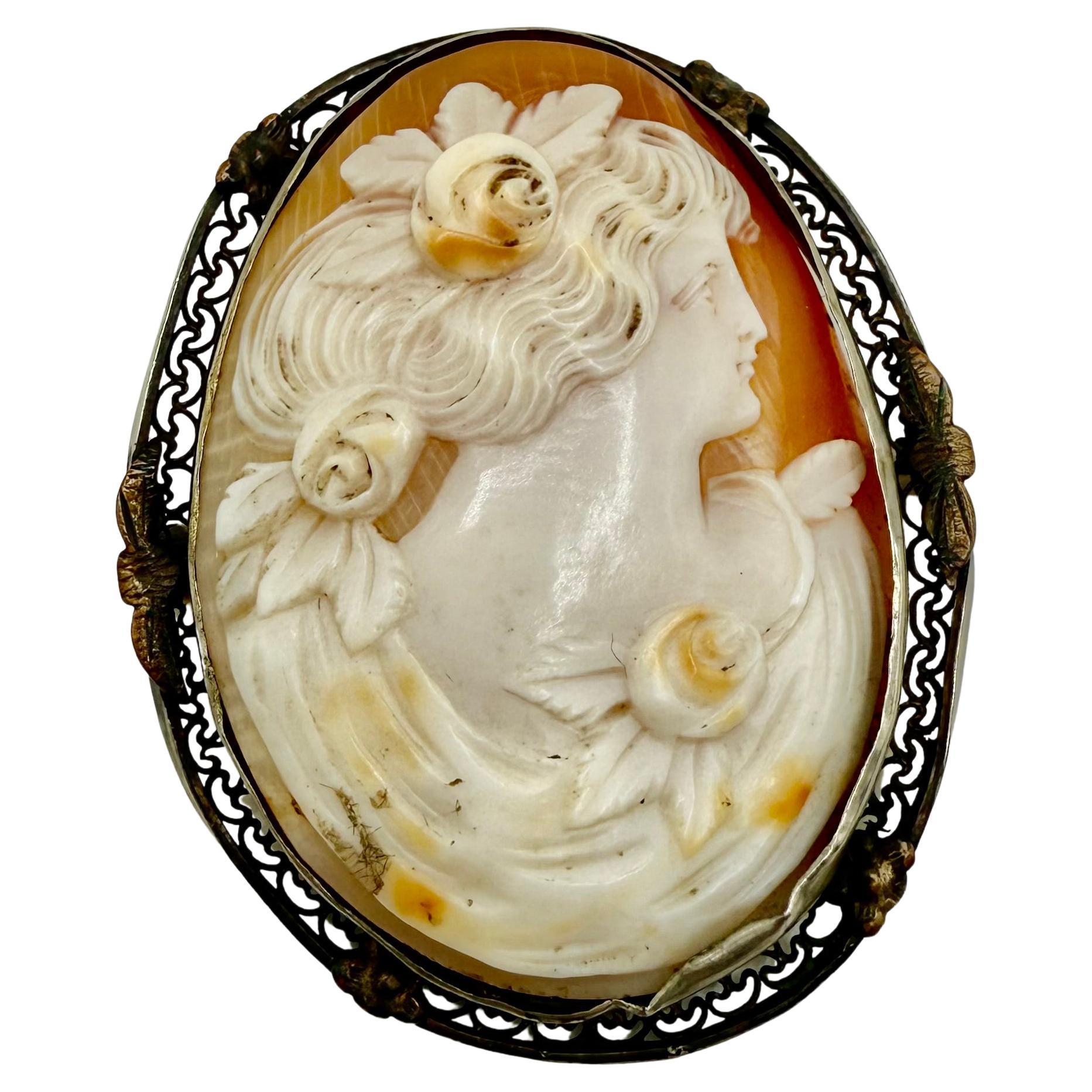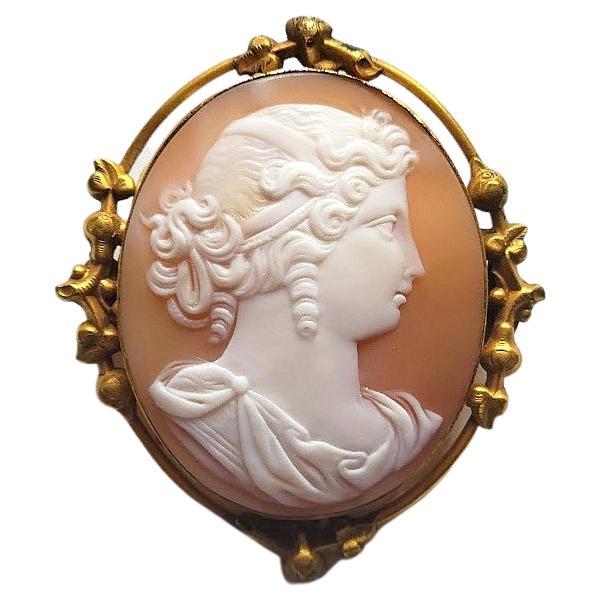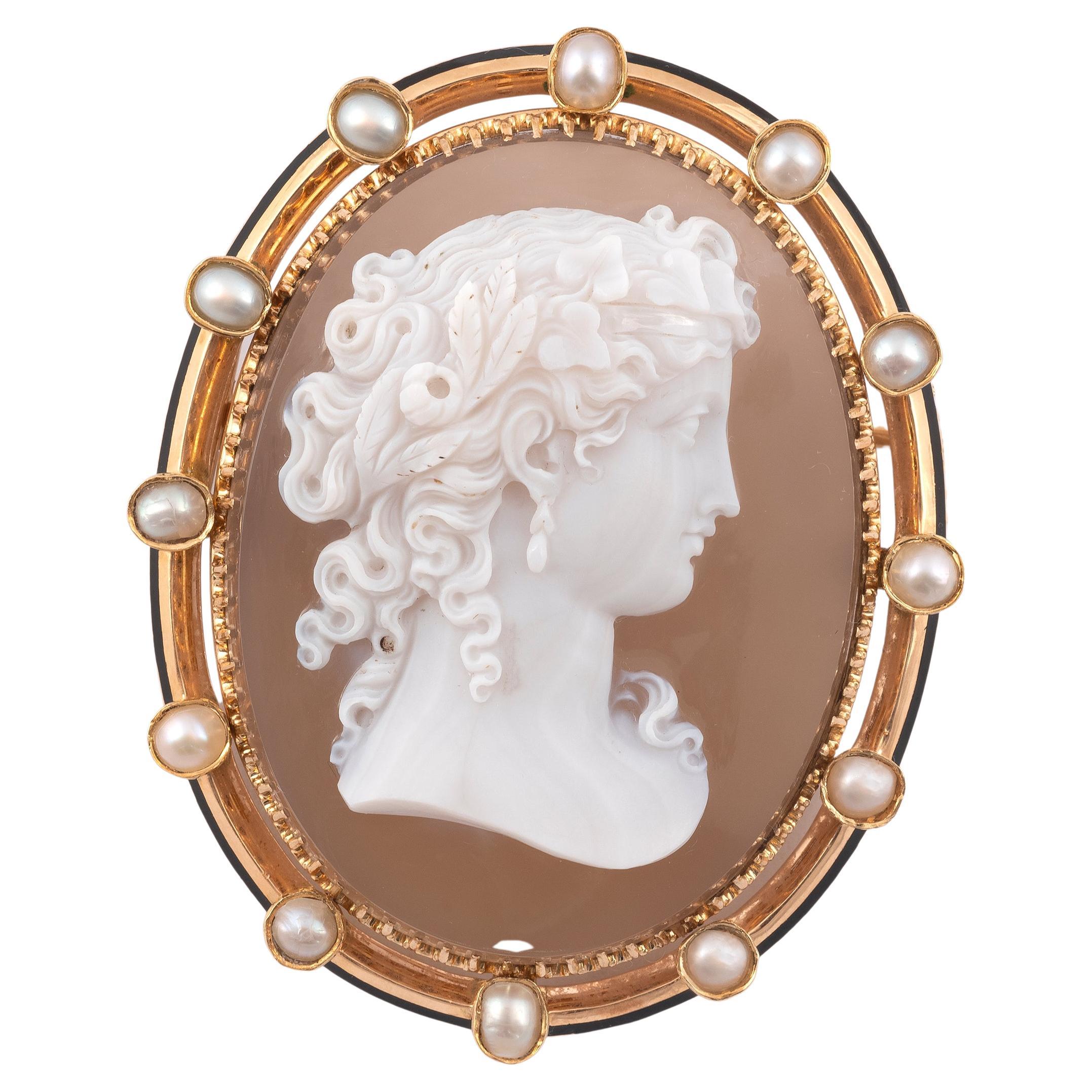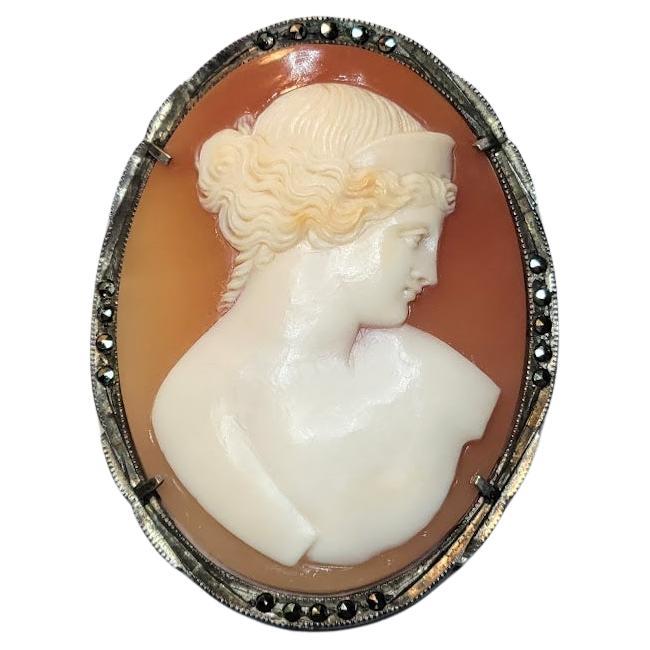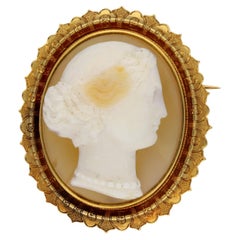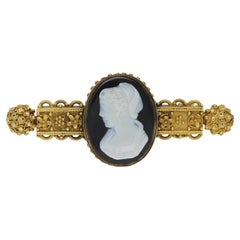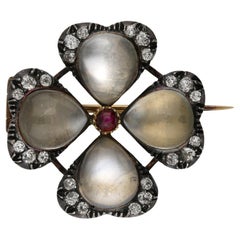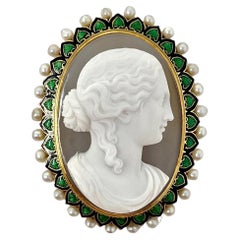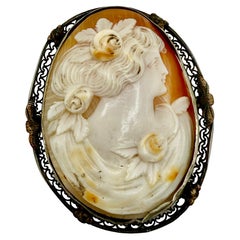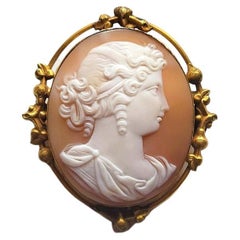Items Similar to John Brogden Shell Cameo Brooch and Earrings, English, circa 1870
Video Loading
Want more images or videos?
Request additional images or videos from the seller
1 of 9
John Brogden Shell Cameo Brooch and Earrings, English, circa 1870
$24,614.72
£18,200
€21,547.53
CA$34,031.99
A$38,121.55
CHF 20,022.82
MX$463,545.78
NOK 253,554.22
SEK 240,691.13
DKK 160,817.51
About the Item
Antique shell cameo brooch and earrings by John Brogden, English, circa 1870. A yellow gold suite of jewellery, the brooch composed of a horizontally situated oval Bull’s Mouth shell cameo of the Greek goddess Selene riding a serpentine dragon in a rubover collet setting, encircled by a conforming frame of gold beading and twisted gold wire punctuated with four gold palmette form plaques engraved and decorated with dark blue enamel and placed at the cardinal points, the reverse mounted with a hinged pin and scroll clasp, the earrings each composed of a vertical oval Bull’s Mouth shell cameo engraved with a bust length portrait of Selene with crescent-set headdress, encircled by a conforming frame matching that of the brooch with the addition of a pendant decoration composed of a horizontal bar of gold beading and twisted gold wires suspending gold link chains graduated from centre and ending in conical gold elements, the reverses mounted with French wire fittings, all in a fitted red leather case, the interior marked ‘FIRST CLASS PARIS MEDAL/ 1855.1867.1851/ PARIS FIRST CLASS & LONDON PRIZE MEDALS/ JOHN BROGDON/ Goldsmith/ MANUFACTORY/ 16, Henrietta St. Covent Garden/ London’.
The cameo—defined as a gem, usually either a mineral or a shell, upon which a design has been carved in relief—is believed to have originated in Hellenistic Greece, during the third century BC. These miniature sculptures, at that time confined to the medium of hardstone, are thought to have been made with the primary purpose of personal adornment. The same practice of mounting cameos in jewellery was then continued by the Ancient Romans, and they are known to have been worn by many a Roman emperor.
After the fall of Rome the fashion for cameos went into a decline, until it was again revived during the Renaissance period, brought about by a keen interest in the ancient world. At this time both antique and contemporary cameos were mounted in jewellery, as well as collected as objet d’art. The art of cameo cutting was revived in Italy, where it would remain a centre for the coming centuries. Again there was a lull in interest in carved gemstones, until the Neoclassical revival of the eighteenth century, largely stimulated by the discoveries of the ancient Roman cities of Pompeii and Herculaneum. As with the Renaissance, antique specimens were generally prized over modern cameos, and the worldliest men in Europe held them among their collections of art and antiques. That said, carving centres in Rome and Torre del Greco (near Naples) in Italy were established in response to the demand of the Grand Tourists, who travelled to Italy and Greece to become educated in the wonders of the ancient world. It was at this time that shell cameos, mostly made in Torre del Greco due to its proximity to the sea, became more popular, owing to the relative ease in carving shell over hardstone. In addition to Rome, hardstone cameos also became a specialty of Idar Oberstein, Germany, which had a long history with both the gem mining and cutting trade.
In a shift away from the collector’s cases of the previous century, the nineteenth century saw a strengthening in the fashion for wearable cameos. After the Empress Josephine donned a cameo-set suite of jewellery at the coronation of Napoleon in 1804, cameo jewellery became all the rage. Napoleon played a further hand in promoting the art by establishing a gemstone carving school in Paris, inspired by his appreciation for the arts of the ancient world. By the mid-nineteenth century shell cameos, in part due to their lightness compared with hardstone cameos, were the height of fashion. Large shell cameos as well as hardstone cameos were set into contemporary mounts, often as suites of jewellery. Some of the best cameos of the nineteenth century—carved by a select group of recognized carvers—were set into revivalist mounts, corresponding to the subject matter.
In Victorian England cameo jewellery was particularly prized, due in part to the fact that the Queen owned and wore a number of cameo jewels. One example which can often be seen in official portraits is the Badge of the Order of Victoria and Albert, carved by Tommaso Saulini of Rome, who also produced cameos for the maker of the present suite, John Brogden. To meet demand some carvers set themselves up in London, including William Schmidt, a German carver from Idar Oberstein, who produced cameos for top London jewellers, including Brogden, Carlo Giuliano and Child & Child. In fact, Schmidt purports to have been the first to carve cameos out of opal, which Brogden reportedly displayed in the Paris Exhibition of 1878. An extant example, now in the collection of the British Museum, was set by the Giuliano firm.
Regarding subject matter, cameos throughout time have been largely figural, from bust length profile portraits to scenes with multiple full-length figures, and sometimes animals. Ancient Greek and Roman cameos often depicted mythological scenes as well as contemporary figures. During the Renaissance, mythological scenes were popular, often taken directly from ancient sculpture, as well as portraits of notable contemporary figures. During the eighteenth and nineteenth centuries, due to the revivalist styles, both Renaissance and Classical subjects were copied and set into matching (and sometimes unmatching) revivalist mounts. From the Renaissance through the Victorian era, being able to recognize the source of the carving in a cameo was a mark of erudition, revealing in the wearer knowledge of Classical art.
As mentioned, the present cameo parure was made by one of the top purveyors of Victorian cameos of the nineteenth century, John Brogden. He first apprenticed for a London watch and clockmaker with a workshop at Bridgewater Square, where he became a partner with James William Garland in 1831. He was then a partner at the firm of Watherston and Brogden, a goldsmithing firm located at 16 Henrietta Street in Convent Garden, fully taking control of the business in 1864—the premise he held when this suite was made. Brogden created jewels in various revivalist styles, most notably the Renaissance and Archaeological revival modes, the latter much inspired by the work of the famed Italian jeweller Castellani. Brodgen exhibited in the 1851 Great Exhibition in London, the 1855 Paris Exposition, and won a gold medal for his jewellery at the 1867 Paris Exposition.
John Brogden was one of the premier dealers in cameo jewellery in London, setting both hardstone and shell cameos made by the best carvers in Italy. He was also a collector of antique cameos, at times lending pieces from his important collection to the South Kensington Museum (today the Victoria & Albert Museum). Furthermore, his wife was an Italian scholar on the subject, one of her accomplishments being that she translated Augusto Castellani’s Gems: Notes and Extracts. A number of cameo-set jewels made by Brogden are part of important museum collections, including the Victoria & Albert Museum, the British Museum and the Birmingham Museum.
The mounts in this parure are in the Greek revival style, indicated by the use of palmette plaques, an ancient Greek design element. The use of twisted wire, gold beading and fringe elements were typical of a more generalized Archeological revival style popular during the third quarter of the nineteenth century. The subject of the cameos themselves is also classical, depicting Selene, the Greco-Roman goddess of the moon, shown full-length riding a serpentine dragon in the brooch, and in profile wearing her crescent moon headdress in the earrings. The cameos themselves are unsigned, as was common with shell cameos. However, Brogden very often set cameos by the famed carver Tommaso Saulini, and then after his death in 1864, his son Luigi, who are known to have worked in both shell and in hardstone. Thus it is quite possible that the cameos in the present set were made by Luigi Saulini (son rather than father, based on the fact that the marks on the case date the piece to after the 1867 Exhibition). There is a very fine hardstone Saulini cameo set in a Greek revival mount by Brogden in the British Museum.
Please note shipping to the United States of America requires the purchaser to fill out a CBP 5106 customs form before the item is shipped. This form is a legal requirement for any item over $2,000 which is being imported into the United States. One of the details the form requests is the purchaser’s social security number or importer’s number.
- Creator:
- Metal:Yellow Gold
- Style:Victorian
- Place of Origin:England
- Period:1870-1879
- Date of Manufacture:Circa 1870
- Condition:Wear consistent with age and use.
- Seller Location:London, GB
- Reference Number:Seller: 262211stDibs: JU11031118648
About the Seller
5.0
Recognized Seller
These prestigious sellers are industry leaders and represent the highest echelon for item quality and design.
1stDibs seller since 2011
65 sales on 1stDibs
Typical response time: 19 hours
- ShippingRetrieving quote...Shipping from: London, United Kingdom
- Return Policy
Authenticity Guarantee
In the unlikely event there’s an issue with an item’s authenticity, contact us within 1 year for a full refund. DetailsMoney-Back Guarantee
If your item is not as described, is damaged in transit, or does not arrive, contact us within 7 days for a full refund. Details24-Hour Cancellation
You have a 24-hour grace period in which to reconsider your purchase, with no questions asked.Vetted Professional Sellers
Our world-class sellers must adhere to strict standards for service and quality, maintaining the integrity of our listings.Price-Match Guarantee
If you find that a seller listed the same item for a lower price elsewhere, we’ll match it.Trusted Global Delivery
Our best-in-class carrier network provides specialized shipping options worldwide, including custom delivery.More From This Seller
View AllVictorian hardstone cameo brooch, French, circa 1900
Located in London, GB
Victorian hardstone cameo brooch. Set with an oval cameo in hardstone depicting the profile of a woman in the classical style, featuring a decorative engraved border and fitted to re...
Category
Antique Early 1900s European Victorian Brooches
Materials
Yellow Gold
Antique Cameo Brooch, circa 1850.
Located in London, GB
Hardstone cameo brooch. Set with a carved hardstone cameo to centre of a bust of a lady in profile within a yellow gold ornate horizontal form, with gold wirework, floral beading and...
Category
Antique 1850s Victorian Brooches
Materials
18k Gold
Carlo & Arthur Giuliano Brooch, Circa 1890.
By Carlo and Arthur Giuliano
Located in London, GB
Moonstone, diamond and ruby cabochon brooch by Carlo & Arthur Giuliano, circa 1890. Four large drop shaped moonstone cabochons with an approximate...
Category
Antique 1890s Victorian Brooches
Materials
Diamond, Moonstone, Ruby, Yellow Gold
Gold and citrine brooch, circa 1866.
Located in London, GB
Victorian citrine and gold brooch. Set with two matching round old cut natural unenhanced Madeira citrines in closed back rubover set...
Category
Antique 1860s Victorian Brooches
Materials
Citrine, Gold
Saint Cecelia Chatelaine Pendant by Froment-Meurice, French, circa 1850
By François-Désiré Froment-Meurice
Located in London, GB
Saint Cecelia chatelaine pendant by Froment-Meurice. A gold and silver pendant in the Renaissance Revival style, the main element composed of an ornately carved openwork architectural structure in the form of an altarpiece, the central niche surmounted by a cupola set with pearls, with scroll and scalloped details to the interior and suspending a fleur-de-lis, containing a figure of Saint Cecelia playing a viola da gamba with two dancing putti to either side, flanked by two smaller raised pedestals issuing fleur-de-lis, each set with a putto (one playing a harp, the other playing a triangle), suspending a double swagged gold chain set with pearls, with two further chains suspending on one side a circular lapis lazuli seal in a trumpet form mount and on the other a watch winder, the whole accented with blue enamel and set to the reverse with a hinged band loop, approximately 9.5cm in total length. Tested yellow gold and silver, French, circa 1850.
François Désiré Froment-Meurice (1802-1855) was one of the most important French jewellery and silversmiths of the nineteenth century, described by Victor Hugo as the Cellini of his age. He exhibited in a number of International Exhibitions, where Queen Victoria and Prince Albert were among his clients. The Renaissance Revival, as seen here, and the Gothic Revival were his two major decorative styles. This piece is also typical of his penchant for placing a silver figure, usually female, within a yellow gold architectural mount. The central figure and flanking putti are identical to those found on two brooches by Froment-Meurice, one in the Birmingham Museum and one in the Schmuckmuseum Pforzheim. Another brooch by Froment-Meurice, in the collection of the Victoria and Albert Museum, features a similar central figure, but this time as an angel with wings, in a silver oval blue enamelled frame. These examples also bear a similar gold and blue enamel architectural mount, and differ only in the surrounding and pendulant embellishments.
Saint Cecelia is the patroness of music, whose feast day is celebrated each November. A Roman maiden, she was amongst the earliest and most famous of the Roman martyrs, reputedly beheaded in 230 AD under the Emperor Alexander Severus. Throughout history, Saint Cecelia has inspired musicians and poets alike, appearing in John Dryden...
Category
Antique 1850s French Victorian More Necklaces
Materials
Lapis Lazuli, Natural Pearl, Yellow Gold, Silver
Georgian miniature and diamond brooch, French, circa 1800.
Located in London, GB
Georgian miniature and diamond brooch. Set with a fine picture of a young country girl with a boy in a closed back rubover setting, bordered by a single row of cushion shape rose cut...
Category
Antique Early 1800s Victorian Brooches
Materials
Diamond, Rose Gold, Silver
You May Also Like
Antique Shell Cameo And Gold Brooch, Jupiter, Juno And Mercury, Circa 1875
Located in London, GB
An antique shell cameo and gold brooch, featuring a conch shell cameo, carved with figures representing the Roman god Jupiter or the Greek god Zeus, with his eagle symbol and the Rom...
Category
Antique 1870s Italian Victorian Brooches
Materials
Gold
Antique 19th Century Hardstone Cameo Brooch in 18K French Enameled Setting
Located in New Orleans, LA
An elegant Victorian lady carved in high relief of banded chalcedony is mounted in a lovely green French enamel and natural pearl setting.
The pin components have French hallmarks a...
Category
Antique 19th Century French Brooches
Victorian Shell Cameo Brooch in Filigree Brass Frame, Late 19th Century
Located in Jacksonville, FL
This exquisite Victorian shell cameo brooch features the finely carved profile of a classical maiden adorned with delicate flowers in her hair an...
Category
Antique Late 19th Century Italian Victorian Brooches
Antique Shell Cameo Brooch Young Lady, late 19th early 20th century
Located in Chesterland, OH
Victorian Cameo Brooch. Fabulous carved Victorian brooch made around the late 19th early 20th century. It depicts a beautiful portrait of a young lady. The execution of the shell is ...
Category
Antique Late 19th Century French Victorian Brooches
Materials
Gold Plate
A 19th Century Oval Hardstone Cameo Brooch
Located in Firenze, IT
The agate carved to depict the portrait of a lady in profile, to a beaded surround set with half pearls, brooch length 5.5cm.
Weight: 33,22gr.
Category
Antique Late 19th Century British Victorian Brooches
Materials
Agate, 18k Gold, Yellow Gold
Antique Shell Cameo Brooch, late 1800s
Located in Chesterland, OH
This fabulous carved Victorian brooch was made around the late 1800s. It depicts a beautiful portrait in the form of ancient Greek and Roman sculptures. The execution of the shell is...
Category
Antique Late 19th Century European Victorian Brooches
Materials
Silver
More Ways To Browse
Cameo Sets
Antique South Jewellery
Antique English Jewelry
Suite Of Jewellery
Suite Of Jewelry
Gemstone Animal Jewelry
Garland Jewellery
Modern Cameo
Queen Victoria Jewelry
Ancient Cameo
Gold Chain And Cameo
Roman Cameo
Bull Jewellery
Gem Cameo
Museum Of Modern Art Jewelry
Serpentine Jewelry
Cardinal Jewelry
Blue Greek Earrings


